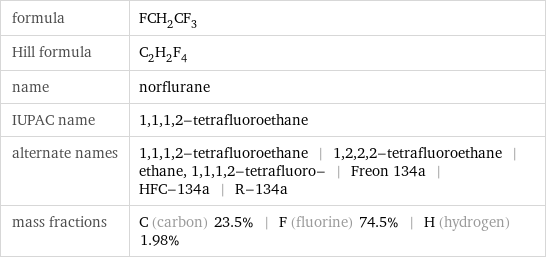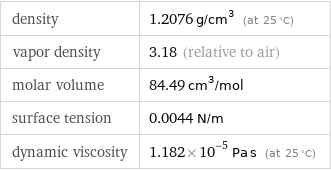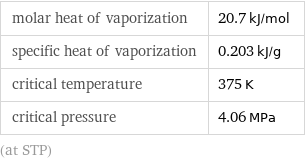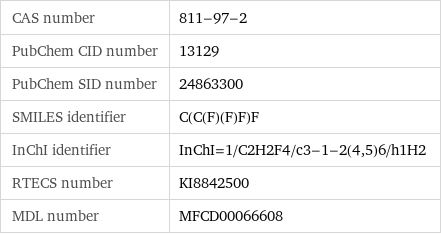Input interpretation

norflurane
Chemical names and formulas

formula | FCH_2CF_3 Hill formula | C_2H_2F_4 name | norflurane IUPAC name | 1, 1, 1, 2-tetrafluoroethane alternate names | 1, 1, 1, 2-tetrafluoroethane | 1, 2, 2, 2-tetrafluoroethane | ethane, 1, 1, 1, 2-tetrafluoro- | Freon 134a | HFC-134a | R-134a mass fractions | C (carbon) 23.5% | F (fluorine) 74.5% | H (hydrogen) 1.98%
Lewis structure

Draw the Lewis structure of norflurane. Start by drawing the overall structure of the molecule: Count the total valence electrons of the carbon (n_C, val = 4), fluorine (n_F, val = 7), and hydrogen (n_H, val = 1) atoms: 2 n_C, val + 4 n_F, val + 2 n_H, val = 38 Calculate the number of electrons needed to completely fill the valence shells for carbon (n_C, full = 8), fluorine (n_F, full = 8), and hydrogen (n_H, full = 2): 2 n_C, full + 4 n_F, full + 2 n_H, full = 52 Subtracting these two numbers shows that 52 - 38 = 14 bonding electrons are needed. Each bond has two electrons, so the above diagram has all the necessary bonds. There are 7 bonds and hence 14 bonding electrons in the diagram. Lastly, fill in the remaining unbonded electrons on each atom. In total, there remain 38 - 14 = 24 electrons left to draw: Answer: | |
3D structure

3D structure
Basic properties

molar mass | 102.03 g/mol phase | gas (at STP) boiling point | -26.5 °C density | 1.2076 g/cm^3 (at 25 °C)
Units

Gas properties (at STP)

density | 1.2076 g/cm^3 (at 25 °C) vapor density | 3.18 (relative to air) molar volume | 84.49 cm^3/mol surface tension | 0.0044 N/m dynamic viscosity | 1.182×10^-5 Pa s (at 25 °C)
Units

Thermodynamic properties

molar heat of vaporization | 20.7 kJ/mol specific heat of vaporization | 0.203 kJ/g critical temperature | 375 K critical pressure | 4.06 MPa (at STP)
Phase diagram

Phase diagram
Units

Chemical identifiers

CAS number | 811-97-2 PubChem CID number | 13129 PubChem SID number | 24863300 SMILES identifier | C(C(F)(F)F)F InChI identifier | InChI=1/C2H2F4/c3-1-2(4, 5)6/h1H2 RTECS number | KI8842500 MDL number | MFCD00066608
Safety properties

flash point | -79 °C

DOT hazard class | 2.2 DOT numbers | 3159
Toxicity properties

RTECS classes | tumorigen | reproductive effector